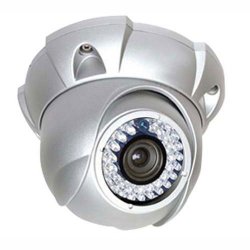 Having problems with night time vandalism or theft? Perhaps you should consider an IR (InfraRed) vandal proof dome camera. These cameras can “see” where humans can’t and are made to be tamper resistant as well.
Having problems with night time vandalism or theft? Perhaps you should consider an IR (InfraRed) vandal proof dome camera. These cameras can “see” where humans can’t and are made to be tamper resistant as well.
The camera is probably the most visible component of a digital video security and surveillance system. In addition, the camera is often placed right in the “heart” of the vandal inflicted area. This makes these cameras all the more incredibly obvious–and the target of even more vandalism.
Therefore, an IR vandal proof dome camera is usually constructed of a tough metal exterior (housing). These housings are designed to take a bit of beating. In addition, the domes or viewing areas where the lens looks outward are generally made of Lexan polycarbonate. These two enhancements will often deter the “would be” vandal, hence the term “Vandal proof.”
Another feature of IR vandal proof dome camera is the ability to capture and record clear, high detailed video images in total darkness using infrared technology. The nice thing about this is that the dome camera can do this automatically and is often set to do so when lighting conditions drop below a certain level (such as less than 1 Lux).
How does the IR vandal proof dome camera capture infrared video images? This is actually due to a “by-product” if you will, of the sensor and the ability of the camera design to allow for IR Light Emitting Diodes or LEDs to be stacked in an array inside the camera housing and around the lens.
Lets take a closer look at how an IR vandal proof dome camera works to understand how it can take both daytime (plenty of visible light) and nighttime (little to no light) high resolution video images. A typical digital video security and surveillance camera works by transferring the light reflected off objects into measurable amounts of electrical impulses.
In order to record video, the camera lens gathers the light reflected off objects in the camera’s field of view and focuses them onto small sensor chips that usually range from 1/4 inch to 1/2 inch square. These sensor chips are excited when light strikes them and give off very small, but measurable amounts of electrical impulses.
There are two different sensor chips used in cameras today. Each goes about getting the measurable impulse differently, but both produce the same end product, a digital video image. These chips are the Charged Coupled Device or CCD and the Complementary Metal Oxide Semiconductor or CMOS.
After the focused light strikes the sensor and the electrical impulses are emitted, Integrated Circuit (IC) chips take over processing and digitizing the electronic information. The signals to this point are actually in an analog format and an analog-to-digital processing chips digitizes the data. In addition, a Digital Signal Processor or DSP also analyzes the digital data before allowing it to leave the camera and makes corrections to the data whenever necessary.
Once this digital data has bee prepared it is ready for transmission to the Digital Video Recorder or DVR and/or monitor. If it is sent to the DVR, it will more than likes undergo some refinement to the data and will be compiled into a digital video file using a COmpression/DECompression or CODEC utility. The CODEC reduces the size of the file while maintaining high quality of the image.
Let’s go back in this process though and take a look at the CCD and the CMOS. IT just so happens that both of the sensors have a “side benefit” that is inherent to the sensors. Both of these sensors inherently “see” IR light naturally. The IR light that they are most sensitive to is in the near infrared spectrum; the same infrared light that is used in television and DVD remote controls.
Another benefit of this particular wavelength of radiation is that it is completely invisible to the human eye. We can’t tell it is there, but the camera can use it like a floodlight or spotlight to capture high resolution, clear, crisp video. IR video incidentally is displayed only as black and white or some other monochromatic configuration because near infrared light is not in the visible color light spectrum.
So if you are looking for a camera that can withstand some mistreatment, yet produce fine color day images and fine black and white IR mode images, we suggest that you consider one of Security Camera King’s IR vandal proof dome camera.
